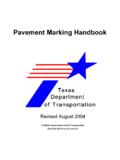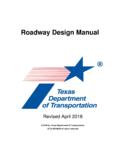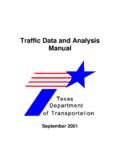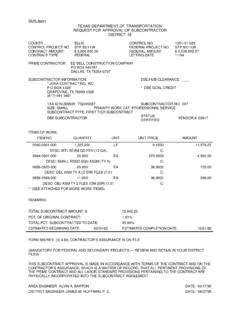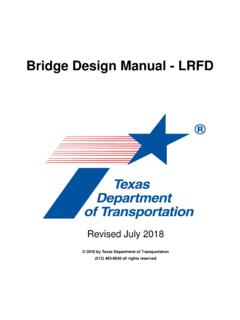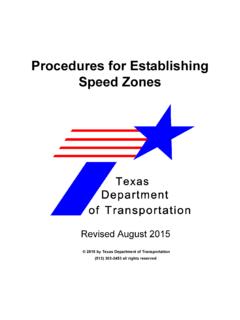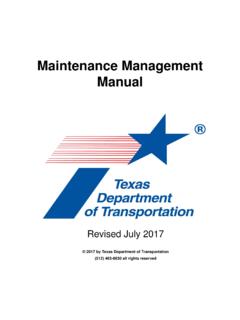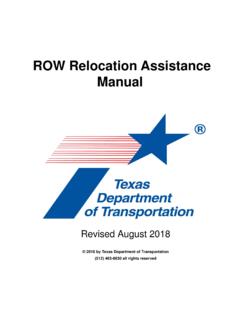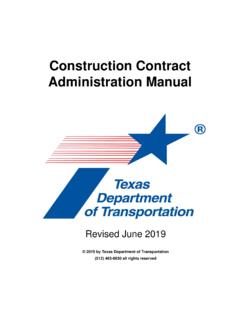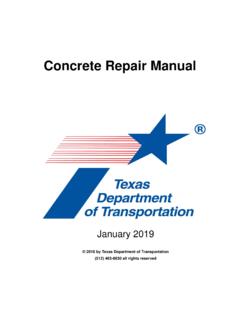Transcription of Geotechnical Manual (GEO)
1 Geotechnical ManualMarch 2018 2018 by Texas Department of Transportation(512) 463-8630 all rights reservedManual Notice 2018-1 From:Gregg A. Freeby, , Director, Bridge DivisionManual: Geotechnical ManualEffective Date:March 01, 2018 PurposeThis Manual provides guidance to districts in Geotechnical investigation and design for project revisions contained in each chapter of this version are to clarify the policy and high-level procedures published in 2012. Generally, revisions to the Manual were to: update information in Chapter 3 regarding Standard Penetration Testing design methodologies; make minor editorial changes to Chapter 4; make editorial changes to the design requirements for various retaining walls in Chapter 6; and provide clarification on the infinite slope analysis in Chapter 5 underwent significant revisions and updates, which include: adding an upper limit to the skin friction and point bearing graphs for Texas Cone Penetration values harder than 100 blows/12 inches; updating the maximum allowable service load table for drilled shafts to include larger diameters; adding new sections on drilled shaft reinforcement, drilled shaft integrity testing, dynamic monitoring, and foundation load testing; clarifications to the layout notes for drilled shafts.
2 Updating the scour section to include new bridges with known foundations, existing bridges with known foundations, existing bridges with unknown foundations, bridge class culverts, and scour critical bridges; and adding a new section on stone protection at revised Manual supersedes prior versions of the more information about any portion of this Manual , please contact the TxDOT Bridge Manual notices are available in a PDF Manuali TxDOT 3/2018 Table of ContentsChapter 1 Manual OverviewSection 1 About this Manual .. 1-2 Purpose of the Manual .. 1-2 Updates .. 1-2 Organization .. 1-2 Feedback .. 1-3 Chapter 2 Soil SurveysSection 1 Soil Surveys .. 2-2 Overview .. 2-2 Review of Existing Data .. 2-2 Hole Location .. 2-2 Bridges .. 2-3 Retaining Walls .. 2-4 Other Structures .. 2-5 Slopes and Embankments .. 2-5 Chapter 3 Field OperationsSection 1 Drilling.
3 3-2 Overview .. 3-2 Access .. 3-2 Utility Clearance .. 3-2 Traffic Control .. 3-2 Drill Hole Filling .. 3-3 Section 2 Sampling Methods .. 3-4 Overview .. 3-4 Section 3 Field Testing .. 3-5 Texas Cone Penetration (TCP) Test .. 3-5 Standard Penetration Test (SPT) .. 3-5In-Place Vane Shear Test.. 3-5 Torvane and Pocket Penetrometer .. 3-5 Chapter 4 Soil and Bedrock LoggingSection 1 Logging .. 4-2 Material Order of Description .. 4-2 Material .. 4-2 Density or Consistency, Hardness .. 4-2 Moisture .. 4-3 Geotechnical Manualii TxDOT 3/2018 Color .. 4-3 Cementation .. 4-3 Descriptive Adjectives.. 4-3 Unified Soil Classification System (ASTM D2487) .. 4-3 Rock Quality Designation (RQD) and Percent Recovery .. 4-4 Log Form .. 4-4 Chapter 5 Foundation DesignSection 1 Foundation Type Selection .. 5-2 Foundation Selection Factors .. 5-2 Foundation Guidelines for Widening Structures.
4 5-3 Section 2 Interpretation of Soil Data.. 5-4 Overview .. 5-4 Disregard Depth.. 5-4 Texas Cone Penetration Test .. 5-4 Laboratory Test .. 5-9 Section 3 Drilled Shafts .. 5-10 Overview .. 5-10 Belled Shafts .. 5-10 Standing Water .. 5-10 Wing Shafts .. 5-11 Service Loads.. 5-11 Drilled Shaft Reinforcement .. 5-11 Drilled Shaft Integrity Testing.. 5-12 Layout Notes .. 5-12 Section 4 Piling .. 5-14 Overview .. 5-14 Wing Piling .. 5-14 Steel Piling Special Considerations .. 5-14 Difficult Driving .. 5-15 Service Loads.. 5-15 Dynamic Monitoring .. 5-15 Section 5 Foundation Load Testing.. 5-17 Section 6 Scour .. 5-18 Analysis .. 5-18 New Bridges with Known Foundations .. 5-18 Existing Bridges with Known Foundations .. 5-20 Existing Bridges with Unknown Foundations.. 5-21 Bridge Class Culverts.. 5-21 Geotechnical Manualiii TxDOT 3/2018 Scour Critical Bridges.
5 5-21 Stone Protection at Bridges .. 5-22 Chapter 6 Retaining WallsSection 1 Retaining Wall Selection .. 6-2 Overview .. 6-2 Section 2 Retaining Wall Layouts .. 6-3 General Content Layout.. 6-3 Plans for Specific Wall Types .. 6-4 Section 3 Design Considerations .. 6-7 General Design .. 6-7 Design Criteria for Specific Wall Types .. 6-7 Section 4 Excavation Support .. 6-14 Overview .. 6-14 Trench Excavation Protection .. 6-14 Temporary Special Shoring .. 6-14 Chapter 7 Slope StabilitySection 1 Overview .. 7-2 Overview .. 7-2 Section 2 Analysis and Design .. 7-3 Global Stability Analysis .. 7-3 Geotechnical Manual1-1 TxDOT 03/2018 Chapter 1 Manual OverviewContents:Section 1 About this ManualGeotechnical Manual1-2 TxDOT 03/2018 Chapter 1 Manual OverviewSection 1 About this ManualSection 1 About this ManualPurpose of the ManualThe purpose of this Manual is to guide districts in Geotechnical investigation and design for project development.
6 Recommendations, background information, and examples for Geotechnical designs are available on the TxDOT to this Manual are summarized in the following table. OrganizationInformation in this Manual is organized into the following Overview. Introductory information on the purpose and organization of the Surveys. Requirements for conducting soil surveys for projects with bridges, retaining walls, slopes and embankments, sign structures, illumination, sound walls, and radio Operations. Requirements for drilling, sampling, and field and Bedrock Logging. Description of material order, level of description, and Foundation Design. Guidelines for selecting foundation types, drilled shafts, piling, and requirements for scour Walls. Requirements for retaining wall selection, layouts, design, and excavation Stability. Requirements for slope stability design and 1-1: Manual Revision HistoryVersionPublication DateSummary of Changes2000-1 August 2000 New Manual2006-1 August 2006 Revision restructuring the Manual to include policy and high-level procedures, with recommendations, examples, and back-ground information now available on the 2012 Clarification to policy previously March 2018 Clarification to policy previously estab-lished and updated material in Chapters 3, 4, 5, 6 and Manual1-3 TxDOT 03/2018 Chapter 1 Manual OverviewSection 1 About this ManualFeedbackDirect any questions or comments on the content of this Manual to the Director of the Bridge Divi-sion, Texas Department of Manual2-1 TxDOT 03/2018 Chapter 2 Soil SurveysContents.
7 Section 1 Soil SurveysGeotechnical Manual2-2 TxDOT 03/2018 Chapter 2 Soil SurveysSection 1 Soil SurveysSection 1 Soil SurveysOverviewConduct soil surveys for projects with the following features: Bridges Retaining walls Slopes and embankments Sign structures Illumination Sound walls Radio towersPerform minimum required testing for all structures, including Texas Cone Penetration (TCP) test-ing at 5-ft. intervals and at strata changes, as well as Rock Quality Designation (RQD) and percent recovery in rock. See the remaining portions of this chapter for requirements for all of Existing DataReview all existing data before determining new data requirements. Old bridge plans are the most common source of information. Old borings containing strength data are usually adequate for new construction. If old borings are used for design, show the old boring data on the plans, and note the date of the boring.
8 Old TCP data may have an additional value listed: the weight of the drill stem when the test was performed. Disregard this number and do not show it if the old borings will be shown in the new LocationThe complexity of geological conditions and the type, length, and width of a structure determine the number of holes required for foundation the test holes in an accessible area. When determining the location of test holes, always avoid overhead power lines and underground utilities. If possible, avoid steep slopes and standing or flowing water. Deviations within a 20-ft. radius of the staked location are not usually excessive, but note them on the logs and obtain the correct surface determining the location and depth of test holes, carefully consider the following factors: Test hole depthGeotechnical Manual2-3 TxDOT 03/2018 Chapter 2 Soil SurveysSection 1 Soil Surveys Lowering of gradeline Channel relocations and channel widenings Scour Foundation loads Foundation typeBridgesThe following figure shows the minimum number of test holes for common types of bridge struc-tures.
9 Do not space test holes more than 300 ft. 2-1. Minimum number of test holes for common types of structuresIn general, drill test holes 15 to 20 ft. deeper than the probable tip elevation of the foundation. Esti-mate the probable founding or tip elevation from the results of Texas Cone Penetration tests and correlation graphs in Texas Cone Penetration Test and experience with foundation conditions in the area. Pay special attention to major structures where high foundation loads are expected. If the depth of the boring is questionable, consult the Bridge Division for a detailed analysis of the pro-jected foundation loads and foundation Crossings. Structures over channels less than 200 ft. wide are classified as minor stream crossings. For these crossings, place a boring on each bank as close to the water s edge as possible. Geotechnical Manual2-4 TxDOT 03/2018 Chapter 2 Soil SurveysSection 1 Soil SurveysIf boring information varies significantly from one side of the channel to the other, a boring in the channel may be stream crossings require core borings in the channel if no existing data is available.
10 A site inspection by the driller or logger is necessary to evaluate site accessibility and special equipment Separations. If the structure borings indicate soft surface soils (fewer than 10 blows per foot), additional borings and testing may be required for the bridge approach Field Exploration. The exploration should include the following: Test hole spacing. Space test holes near each abutment of the proposed structure plus a suffi-cient number of intermediate holes to determine the depth and location of all significant soil and rock strata. If you do not get a reasonable correlation between borings (for example, TCP data, stratigraphy), consult with the project engineer to determine the need for additional holes. Texas Cone Penetration tests. Conduct Texas Cone Penetration tests at 5-ft. intervals beginning at a 5-ft. depth. Standard penetration test data is not acceptable for foundation design using the TxDOT design procedure.
